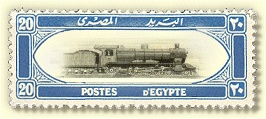

December 23, 2015. |
|
The file of Egyptian Travelling Post Office markings below is the result of a massive combined effort by members of the Egypt Study Circle over the last couple of years,
combined eventually by the Secretary into a single element updating and enlarging the TPO "bible", Peter Smith's The Travelling Post Offices of Egypt, which was published
as long ago as 1983.
When members got together at study meetings with a view to reviewing the dates recorded by Peter Smith it quickly became apparent that several markings did not quite "fit"" the book’s illustrations. And so a careful study was made, based specifically on the meticulous lifetime collection of Peter Heim (now in the care of Sami Sadek), and that of Ibrahim Shoukry, which continues to grow as he delves further into the depths of Egypt's light railways. Invaluable assistance was given by a number of members at the study meetings, reflected in the initials placed after early/late dates. Special thanks should go to Peter Andrews, Ted Fraser-Smith, Lucien Toutounji, Cyril Defriez, Paul Green, Peter Grech, among many others, for their help and assistance. Dates without initials are extracted from the original book, most of them sight-unseen. In the list that follows Peter Smith's basic types have first been analysed - and then compared with examples discovered during the study. Departures from the original types are labelled in red as potential variants, illustrated in scan form - with no drawings to complicate matters further; what you see is what appeared on the cover or card - and with brief description of how the variant is different from the original. In many cases this is simply a matter of month-indicator in European or Roman cyphers; in others it is more significant. It is important to make two points: 1. This study is not complete - we invite members to update, to make comments, to point out new "variants"". 2. We have purposely not given apparent varieties new type names: the original work was groundbreaking and massively significant. What our study groups have discovered does not in any way disturb the original division into types, merely fine-tunes some elements of it. Our thanks go to the master, Peter Smith, without whose original work none of this would have been possible. Mike Murphy |
| List |
|
|